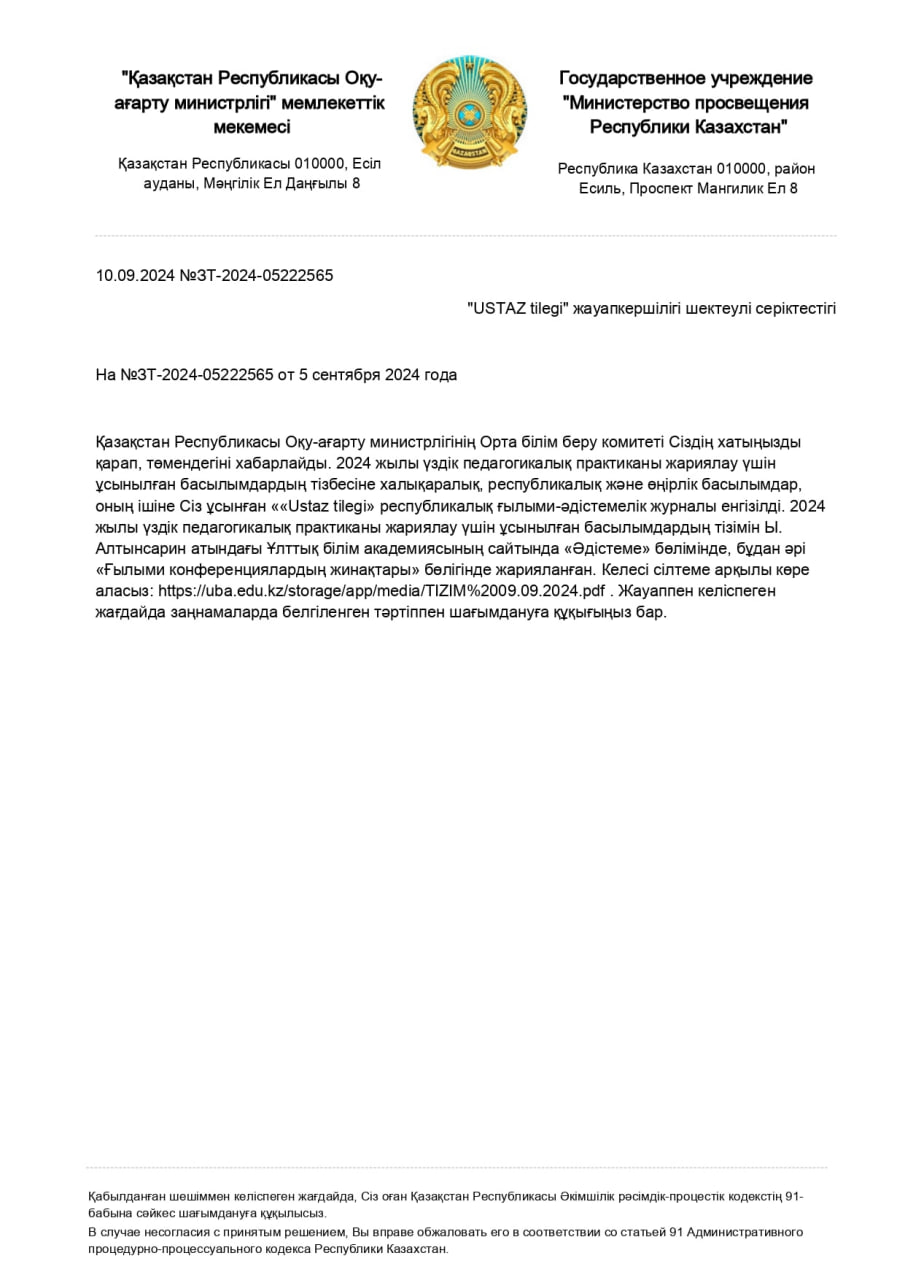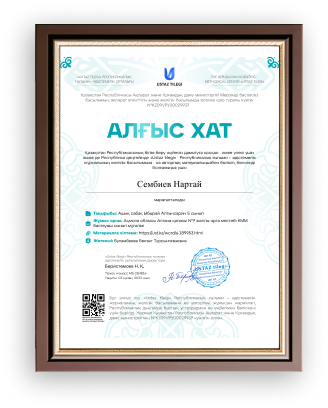
|
LESSON |
|
|||||||||||||||||||||||
|
Date: 19.012023 |
Teacher’s name: Aizhan Sarsentaevna |
|||||||||||||||||||||||
|
Grade: 11__ |
Number present: |
Absent: |
||||||||||||||||||||||
|
Themes of the Lesson: |
Letters to the Editor |
|||||||||||||||||||||||
|
Learning objective(s) that this lesson is contributing to |
11.2.4 understand implied meaning in unsupported extended talk on a wide range of general and curricular topics, including talk on a growing range of unfamiliar topics 11.4.1 understand main points in extended texts on a wide range of familiar and unfamiliar general and curricular topics 11.1.3 respect differing points of view 11.1.9 use imagination to express thoughts, ideas, experiences and feelings |
|||||||||||||||||||||||
|
Lesson objectives |
Most learners will be able to:
|
|||||||||||||||||||||||
|
Some learners will be able to:
|
||||||||||||||||||||||||
|
A few learners will be able to:
|
||||||||||||||||||||||||
|
Value links |
Respect, Cooperation, and Life-long learning are instilled during lessons. |
|||||||||||||||||||||||
|
Cross-curricular links |
Global Perspectives, History/Social Studies |
|||||||||||||||||||||||
|
ICT skills |
Use of computer, smart board and online dictionaries |
|||||||||||||||||||||||
|
Previous learning |
|
|||||||||||||||||||||||
|
Intercultural awareness |
The history and significance of significance of the innovative London Underground map |
|||||||||||||||||||||||
|
Kazakh culture |
Significance of the innovative London Underground map today in Kazakhstan |
|||||||||||||||||||||||
|
Health and safety |
Make sure power cords are not a tripping hazard; bags are not blocking access ways or exits; everyday classroom precautions |
|||||||||||||||||||||||
|
Plan |
||||||||||||||||||||||||
|
Planned timings |
Planned activities |
Resources |
||||||||||||||||||||||
|
5-10min |
Warm-up: Pair up less able students with more-able students. Share a map of the London Underground with students and have them do the following tasks (P):
Then ask analytic and creative questions to the whole class (WC):
|
PPT (slides 3-4) Handout 1 |
||||||||||||||||||||||
|
10-15min 15-25min 25-30min 30-35min 35-40min |
Pre-Listening: Tell students that they are going to watch a talk about how the map for the London Underground was developed. Before they watch have students match these words from the text with their meanings. Peer assessment: Have students swap the Handout 2 with the person next to them. Show them Slide X and have them check the answers. Answer keys:
Differentiation: After checking the answers, make sure students can pronounce each item, as they will hear them in the video. The underlined syllables are stressed. Have more-able students read the words out loud. Listening: Task 1. Have students watch the short talk and then ask them these questions (WC):
Assessment criteria:
Task 2. Present the questions and watch each part again. Each section is short, so play the video several times if students want to listen to it again. Self-assessment: Show them Slide X and have them check their own answers. Answer keys: 1. Rivers, bodies of water, trees and parks, and stations of course! 2. It was very crowded with lots of information included in a very small space. 3. The edges showed stations in the wrong places because they couldn't even fit on the paper due to their distance from the city center. 4. Passengers only want to plan a journey - i.e. getting on and off the right trains. 5. The system is described as "a complicated mess of spaghetti". 6. Because they gave away a thousand of the maps in only one hour. 7. They use color to show different lines and symbols to show different types of station. 8. 1. The first one is focus (on who you're doing this for); 2. The second principle is simplicity (the shortest way to deliver what is needed); 3. The last thing is thinking in a cross-disciplinary way, e.g. an electrical engineer using his skills to design a map for a transport system. Post-listening: Tell students that they have to read the phrases from the talk and choose the best meaning for each one in this context. Self-assessment: Show them Slide X and have them check their own answers. Answer keys:
UOE (Grammar Revision): Tell students that the underlined tense is present perfect (have/has + past participle), which is normally used to talk about events in an unfinished past context. It is used here, even though these actions really belong in a finished past context, to make the action seem more relevant to the present and engage the listener's attention. You could also point out that in the same way, historians sometimes use present simple to describe past actions, e.g.: - The king wanted all his men to fight, so he called them together and said ... - The king wants all his men to fight, so he calls them together and says ... Home assignment: Students can choose one of the three topics provided or use their own ideas. They could do the research in their own time to produce the text. The frame offers support and limits the length, but students don't have to use it. The text could be submitted as a written assignment for marking or presentations could be delivered in a subsequent lesson with feedback from the teacher and classmates. |
PPT (slide 5) Handout 2 Video PPT (slide 6) PPT (slide 7) Handout 3
PPT (slide 8) Handout 4 PPT (Slides from 9 to 16)
|
||||||||||||||||||||||
|
REFLECTION |
||||||||||||||||||||||||
|
Were the lesson objectives/learning objectives realistic? |
|
|||||||||||||||||||||||
|
What did the learners learn today? |
|
|||||||||||||||||||||||
|
What was the learning atmosphere like? |
|
|||||||||||||||||||||||
|
Did my planned differentiation work well? |
|
|||||||||||||||||||||||
|
Did I stick to timings? |
|
|||||||||||||||||||||||
|
What changes did I make from my plan and why? |
|
|||||||||||||||||||||||
|
Summary evaluation What two things went really well (consider both teaching and learning)? 1: 2: What two things would have improved the lesson (consider both teaching and learning)? 1: 2: What have I learned from this lesson about the class or achievements/difficulties of individuals that will inform my next lesson? |
||||||||||||||||||||||||
жүктеу мүмкіндігіне ие боласыз
Бұл материал сайт қолданушысы жариялаған. Материалдың ішінде жазылған барлық ақпаратқа жауапкершілікті жариялаған қолданушы жауап береді. Ұстаз тілегі тек ақпаратты таратуға қолдау көрсетеді. Егер материал сіздің авторлық құқығыңызды бұзған болса немесе басқа да себептермен сайттан өшіру керек деп ойласаңыз осында жазыңыз
Letters to the Editor
Letters to the Editor
|
LESSON |
|
|||||||||||||||||||||||
|
Date: 19.012023 |
Teacher’s name: Aizhan Sarsentaevna |
|||||||||||||||||||||||
|
Grade: 11__ |
Number present: |
Absent: |
||||||||||||||||||||||
|
Themes of the Lesson: |
Letters to the Editor |
|||||||||||||||||||||||
|
Learning objective(s) that this lesson is contributing to |
11.2.4 understand implied meaning in unsupported extended talk on a wide range of general and curricular topics, including talk on a growing range of unfamiliar topics 11.4.1 understand main points in extended texts on a wide range of familiar and unfamiliar general and curricular topics 11.1.3 respect differing points of view 11.1.9 use imagination to express thoughts, ideas, experiences and feelings |
|||||||||||||||||||||||
|
Lesson objectives |
Most learners will be able to:
|
|||||||||||||||||||||||
|
Some learners will be able to:
|
||||||||||||||||||||||||
|
A few learners will be able to:
|
||||||||||||||||||||||||
|
Value links |
Respect, Cooperation, and Life-long learning are instilled during lessons. |
|||||||||||||||||||||||
|
Cross-curricular links |
Global Perspectives, History/Social Studies |
|||||||||||||||||||||||
|
ICT skills |
Use of computer, smart board and online dictionaries |
|||||||||||||||||||||||
|
Previous learning |
|
|||||||||||||||||||||||
|
Intercultural awareness |
The history and significance of significance of the innovative London Underground map |
|||||||||||||||||||||||
|
Kazakh culture |
Significance of the innovative London Underground map today in Kazakhstan |
|||||||||||||||||||||||
|
Health and safety |
Make sure power cords are not a tripping hazard; bags are not blocking access ways or exits; everyday classroom precautions |
|||||||||||||||||||||||
|
Plan |
||||||||||||||||||||||||
|
Planned timings |
Planned activities |
Resources |
||||||||||||||||||||||
|
5-10min |
Warm-up: Pair up less able students with more-able students. Share a map of the London Underground with students and have them do the following tasks (P):
Then ask analytic and creative questions to the whole class (WC):
|
PPT (slides 3-4) Handout 1 |
||||||||||||||||||||||
|
10-15min 15-25min 25-30min 30-35min 35-40min |
Pre-Listening: Tell students that they are going to watch a talk about how the map for the London Underground was developed. Before they watch have students match these words from the text with their meanings. Peer assessment: Have students swap the Handout 2 with the person next to them. Show them Slide X and have them check the answers. Answer keys:
Differentiation: After checking the answers, make sure students can pronounce each item, as they will hear them in the video. The underlined syllables are stressed. Have more-able students read the words out loud. Listening: Task 1. Have students watch the short talk and then ask them these questions (WC):
Assessment criteria:
Task 2. Present the questions and watch each part again. Each section is short, so play the video several times if students want to listen to it again. Self-assessment: Show them Slide X and have them check their own answers. Answer keys: 1. Rivers, bodies of water, trees and parks, and stations of course! 2. It was very crowded with lots of information included in a very small space. 3. The edges showed stations in the wrong places because they couldn't even fit on the paper due to their distance from the city center. 4. Passengers only want to plan a journey - i.e. getting on and off the right trains. 5. The system is described as "a complicated mess of spaghetti". 6. Because they gave away a thousand of the maps in only one hour. 7. They use color to show different lines and symbols to show different types of station. 8. 1. The first one is focus (on who you're doing this for); 2. The second principle is simplicity (the shortest way to deliver what is needed); 3. The last thing is thinking in a cross-disciplinary way, e.g. an electrical engineer using his skills to design a map for a transport system. Post-listening: Tell students that they have to read the phrases from the talk and choose the best meaning for each one in this context. Self-assessment: Show them Slide X and have them check their own answers. Answer keys:
UOE (Grammar Revision): Tell students that the underlined tense is present perfect (have/has + past participle), which is normally used to talk about events in an unfinished past context. It is used here, even though these actions really belong in a finished past context, to make the action seem more relevant to the present and engage the listener's attention. You could also point out that in the same way, historians sometimes use present simple to describe past actions, e.g.: - The king wanted all his men to fight, so he called them together and said ... - The king wants all his men to fight, so he calls them together and says ... Home assignment: Students can choose one of the three topics provided or use their own ideas. They could do the research in their own time to produce the text. The frame offers support and limits the length, but students don't have to use it. The text could be submitted as a written assignment for marking or presentations could be delivered in a subsequent lesson with feedback from the teacher and classmates. |
PPT (slide 5) Handout 2 Video PPT (slide 6) PPT (slide 7) Handout 3
PPT (slide 8) Handout 4 PPT (Slides from 9 to 16)
|
||||||||||||||||||||||
|
REFLECTION |
||||||||||||||||||||||||
|
Were the lesson objectives/learning objectives realistic? |
|
|||||||||||||||||||||||
|
What did the learners learn today? |
|
|||||||||||||||||||||||
|
What was the learning atmosphere like? |
|
|||||||||||||||||||||||
|
Did my planned differentiation work well? |
|
|||||||||||||||||||||||
|
Did I stick to timings? |
|
|||||||||||||||||||||||
|
What changes did I make from my plan and why? |
|
|||||||||||||||||||||||
|
Summary evaluation What two things went really well (consider both teaching and learning)? 1: 2: What two things would have improved the lesson (consider both teaching and learning)? 1: 2: What have I learned from this lesson about the class or achievements/difficulties of individuals that will inform my next lesson? |
||||||||||||||||||||||||

шағым қалдыра аласыз















